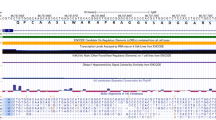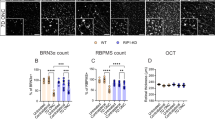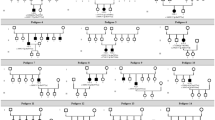Abstract
Glaucoma is a genetically heterogeneous disorder and is the second cause of blindness worldwide owing to the progressive degeneration of retinal ganglion neurons. Very few genes causing glaucoma were identified to this date. In this study, we screened 10 candidate genes of glaucoma between the D14S261 and D14S121 markers of chromosome 14q11, a critical region previously linked to primary open-angle glaucoma (POAG). Mutation analyses of two large cohorts of patients with POAG, normal tension glaucoma (NTG) and juvenile open-angle glaucoma (JOAG), and control subjects, found only association of non-synonymous heterozygous variants of the retinitis pigmentosa GTPase regulator-interacting protein 1 (RPGRIP1) with POAG, NTG and JOAG. The 20 non-synonymous variants identified in RPGRIP1 were all distinct from variants causing photoreceptor dystrophies and were found throughout all but one domain (RPGR-interacting domain) of RPGRIP1. Among them, 14 missense variants clustered within or around the C2 domains of RPGRIP1. Yeast two-hybrid analyses of a subset of the missense mutations within the C2 domains of RPGRIP1 shows that five of them (p.R598Q, p.A635G, p.T806I, p.A837G and p.I838V) decrease the association of the C2 domains with nephrocystin-4 (NPHPH). When considering only these five confirmed C2-domain mutations, the association remains statistically significant (P=0.001). Altogether, the data support that heterozygous non-synonymous variants of RPGRIP1 may cause or increase the susceptibility to various forms of glaucoma and that among other factors, physical impairment of the interaction of RPGRIP1with different proteins may contribute to the pathogenesis of forms of glaucoma.
Similar content being viewed by others
Log in or create a free account to read this content
Gain free access to this article, as well as selected content from this journal and more on nature.com
or
Accession codes
References
Kwon YH, Fingert JH, Kuehn MH, Alward WL : Primary open-angle glaucoma. N Engl J Med 2009; 360: 1113–1124.
Thylefors B, Negrel AD, Pararajasegaram R, Dadzie KY : Global data on blindness. Bull World Health Organ 1995; 73: 115–121.
Quigley HA, Broman AT : The number of people with glaucoma worldwide in 2010 and 2020. Br J Ophthalmol 2006; 90: 262–267.
Shields MB : Staging glaucoma for the twenty-first century: sixth Chandler-Grant Lecture. J Glaucoma 1996; 5: 340–344.
Wiggs JL, Damji KF, Haines JL, Pericak-Vance MA, Allingham RR : The distinction between juvenile and adult-onset primary open-angle glaucoma. Am J Hum Genet 1996; 58: 243–244.
Wiggs JL : Genetic etiologies of glaucoma. Arch Ophthalmol 2007; 125: 30–37.
Allingham RR, Liu Y, Rhee DJ : The genetics of primary open-angle glaucoma: a review. Exp Eye Res 2009; 88: 837–844.
Stone EM, Fingert JH, Alward WL et al: Identification of a gene that causes primary open angle glaucoma. Science 1997; 275: 668–670.
Rezaie T, Child A, Hitchings R et al: Adult-onset primary open-angle glaucoma caused by mutations in optineurin. Science 2002; 295: 1077–1079.
Monemi S, Spaeth G, DaSilva A et al: Identification of a novel adult-onset primary open-angle glaucoma (POAG) gene on 5q22.1. Hum Mol Genet 2005; 14: 725–733.
Fan BJ, Wang DY, Lam DS, Pang CP : Gene mapping for primary open angle glaucoma. Clin Biochem 2006; 39: 249–258.
Fuse N : Genetic bases for glaucoma. Tohoku J Exp Med 2010; 221: 1–10.
Pasutto F, Chavarria-Soley G, Mardin CY et al: Heterozygous loss of function variants in CYP1B1 predispose to primary open angle glaucoma. Invest Ophthalmol Vis Sci 2010; 51: 249–254.
Pasutto F, Matsumoto T, Mardin CY et al: Heterozygous NTF4 mutations impairing neurotrophin-4 signaling in patients with primary open-angle glaucoma. Am J Hum Genet 2009; 85: 447–456.
van Koolwijk LM, Despriet DD, van Duijn CM et al: Genetic contributions to glaucoma: heritability of intraocular pressure, retinal nerve fiber layer thickness, and optic disc morphology. Invest Ophthalmol Vis Sci 2007; 48: 3669–3676.
Berdahl JP, Allingham RR, Johnson DH : Cerebrospinal fluid pressure is decreased in primary open-angle glaucoma. Ophthalmology 2008; 115: 763–768.
Wiggs JL, Allingham RR, Hossain A et al: Genome-wide scan for adult onset primary open angle glaucoma. Hum Mol Genet 2000; 9: 1109–1117.
Nemesure B, Jiao X, He Q et al: A genome-wide scan for primary open-angle glaucoma (POAG): the Barbados Family Study of open-angle glaucoma. Hum Genet 2003; 112: 600–609.
Pasutto F, Mardin CY, Michels-Rautenstrauss K et al: Profiling of WDR36 missense variants in German patients with glaucoma. Invest Ophthalmol Vis Sci 2008; 49: 270–274.
Weisschuh N, Wolf C, Wissinger B, Gramer E : Variations in the WDR36 gene in German patients with normal tension glaucoma. Mol Vis 2007; 13: 724–729.
Roepman R, Letteboer SJ, Arts HH et al: Interaction of nephrocystin-4 and RPGRIP1 is disrupted by nephronophthisis or Leber congenital amaurosis-associated mutations. Proc Natl Acad Sci USA 2005; 102: 18520–18525.
Ferreira PA : Insights into X-linked retinitis pigmentosa type 3, allied diseases and underlying pathomechanisms. Hum Mol Genet 2005; 14 Spec No.2: R259–R267.
Roepman R, Bernoud-Hubac N, Schick DE et al: The retinitis pigmentosa GTPase regulator (RPGR) interacts with novel transport-like proteins in the outer segments of rod photoreceptors. Hum Mol Genet 2000; 9: 2095–2105.
Castagnet P, Mavlyutov T, Cai Y, Zhong F, Ferreira P : RPGRIP1s with distinct neuronal localization and biochemical properties associate selectively with RanBP2 in amacrine neurons. Hum Mol Genet 2003; 12: 1847–1863.
Lu X, Ferreira PA : Identification of novel murine- and human-specific RPGRIP1 splice variants with distinct expression profiles and subcellular localization. Invest Ophthalmol Vis Sci 2005; 46: 1882–1890.
Mavlyutov TA, Zhao H, Ferreira PA : Species-specific subcellular localization of RPGR and RPGRIP isoforms: implications for the phenotypic variability of congenital retinopathies among species. Hum Mol Genet 2002; 11: 1899–1907.
Lu X, Guruju M, Oswald J, Ferreira PA : Limited proteolysis differentially modulates the stability and subcellular localization of domains of RPGRIP1 that are distinctly affected by mutations in Leber's congenital amaurosis. Hum Mol Genet 2005; 14: 1327–1340.
Rizo J, Sudhof TC : C2-domains, structure and function of a universal Ca2+-binding domain. J Biol Chem 1998; 273: 15879–15882.
Nalefski EA, Falke JJ : The C2 domain calcium-binding motif: structural and functional diversity. Protein Sci 1996; 5: 2375–2390.
Chang B, Khanna H, Hawes N et al: In-frame deletion in a novel centrosomal/ciliary protein CEP290/NPHP6 perturbs its interaction with RPGR and results in early-onset retinal degeneration in the rd16 mouse. Hum Mol Genet 2006; 15: 1847–1857.
Arts HH, Cremers FP, Knoers NV, Roepman R : Focus on molecules: RPGRIP1. Exp Eye Res 2009; 88: 332–333.
Oti M, Huynen MA, Brunner HG : Phenome connections. Trends Genet 2008; 24: 103–106.
Gong G, Kosoko-Lasaki O, Haynatzki GR, Wilson MR : Genetic dissection of myocilin glaucoma. Hum Mol Genet 2004; 13 Spec No 1: R91–R102.
Bodmer W, Bonilla C : Common and rare variants in multifactorial susceptibility to common diseases. Nat Genet 2008; 40: 695–701.
Dryja TP, Adams SM, Grimsby JL et al: Null RPGRIP1 alleles in patients with Leber congenital amaurosis. Am J Hum Genet 2001; 68: 1295–1298.
Booij JC, Florijn RJ, ten Brink JB et al: Identification of mutations in the AIPL1, CRB1, GUCY2D, RPE65, and RPGRIP1 genes in patients with juvenile retinitis pigmentosa. J Med Genet 2005; 42: e67.
Galvin JA, Fishman GA, Stone EM, Koenekoop RK : Clinical phenotypes in carriers of Leber congenital amaurosis mutations. Ophthalmology 2005; 112: 349–356.
Raz D, Perlman I, Percicot CL, Lambrou GN, Ofri R : Functional damage to inner and outer retinal cells in experimental glaucoma. Invest Ophthalmol Vis Sci 2003; 44: 3675–3684.
Vincent AL, Billingsley G, Buys Y et al: Digenic inheritance of early-onset glaucoma: CYP1B1, a potential modifier gene. Am J Hum Genet 2002; 70: 448–460.
Aroca-Aguilar JD, Sanchez-Sanchez F, Martinez-Redondo F, Coca-Prados M, Escribano J : Heterozygous expression of myocilin glaucoma mutants increases secretion of the mutant forms and reduces extracellular processed myocilin. Mol Vis 2008; 14: 2097–2108.
Zhou Z, Vollrath D : A cellular assay distinguishes normal and mutant TIGR/myocilin protein. Hum Mol Genet 1999; 8: 2221–2228.
Jonas JB, Papastathopoulos K : Ophthalmoscopic measurement of the optic disc. Ophthalmology 1995; 102: 1102–1106.
Acknowledgements
We thank all patients and control individuals for their participation, Olga Zwenger for technical assistance and Juliane Niedzella for patients’ recruitment support. This study was supported by Grant SFB 539 from the German Research Foundation. PAF was supported by grants from the National Institutes of Health (GM083165, EY019492 and 2P30-EY005722). PAF is the Jules and Doris Stein Research to Prevent Blindness Professor.
Author information
Authors and Affiliations
Corresponding author
Ethics declarations
Competing interests
The authors declare no conflict of interest.
Additional information
WEB RESOURCES
The URLs for data presented herein are as follows:
National Center for Biotechnology Information (NCBI), http://www.ncbi.nlm.nih.gov/
Genome Browser of the University of California Santa Cruz (UCSC), http://genome.ucsc.edu/cgi-bin/hgTracks (reference sequences ssed: NT_026437 and NM_020366 and NP_065099)
Ensembl Database (http://www.ensembl.org).
ClustalW, http://www.ebi.ac.uk/clustalw/
Online Mendelian Inheritance in Man (OMIM): http://www.ncbi.nlm.nih.gov/entrez/query.fcgi?db=OMIM/.
Rights and permissions
About this article
Cite this article
Fernández-Martínez, L., Letteboer, S., Mardin, C. et al. Evidence for RPGRIP1 gene as risk factor for primary open angle glaucoma. Eur J Hum Genet 19, 445–451 (2011). https://doi.org/10.1038/ejhg.2010.217
Received:
Revised:
Accepted:
Published:
Issue date:
DOI: https://doi.org/10.1038/ejhg.2010.217
Keywords
This article is cited by
-
Ocular abnormalities in a large patient cohort with retinitis pigmentosa in Western China
BMC Ophthalmology (2021)
-
A novel mutation in the PRPH2 gene in a Chinese pedigree with retinitis pigmentosa and angle-closure glaucoma
BMC Ophthalmology (2021)
-
Applying next generation sequencing with microdroplet PCR to determine the disease-causing mutations in retinal dystrophies
BMC Ophthalmology (2017)
-
Selective loss of RPGRIP1-dependent ciliary targeting of NPHP4, RPGR and SDCCAG8 underlies the degeneration of photoreceptor neurons
Cell Death & Disease (2012)



